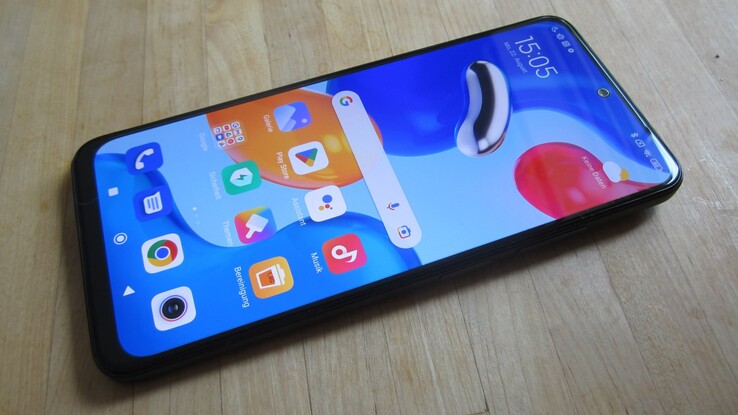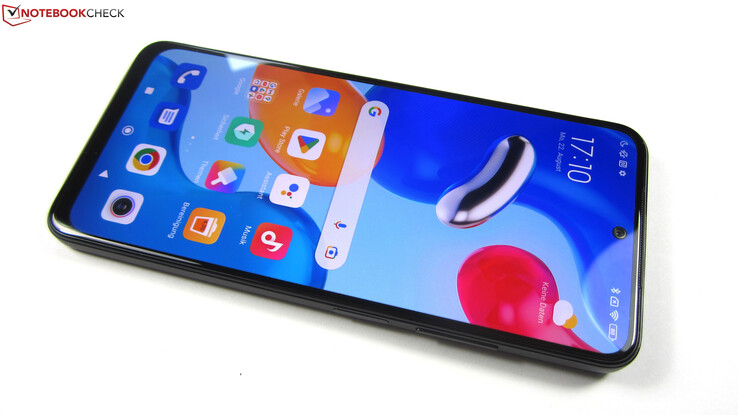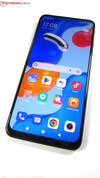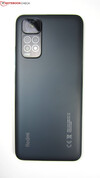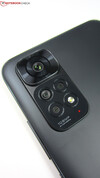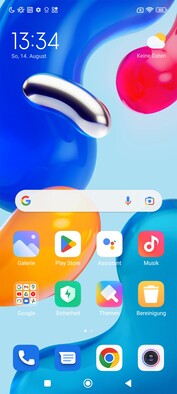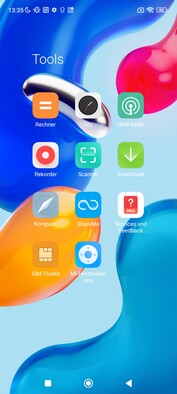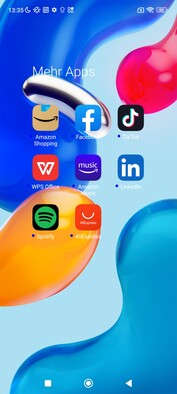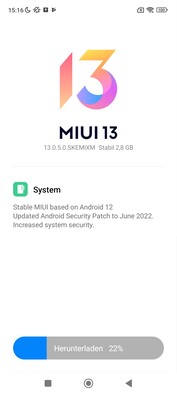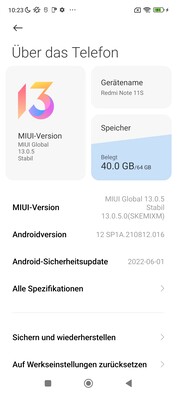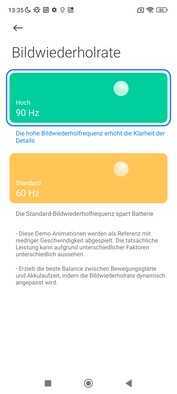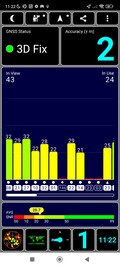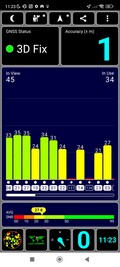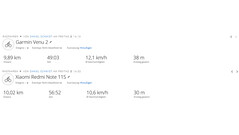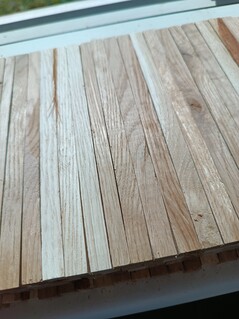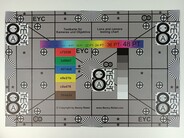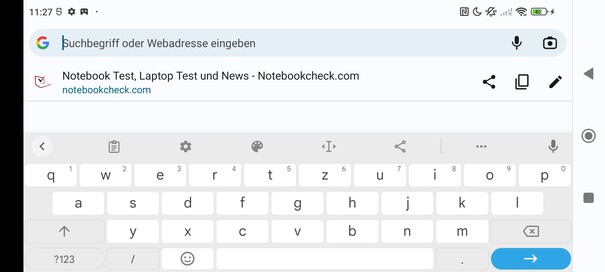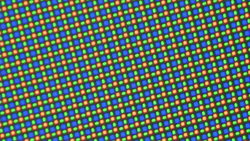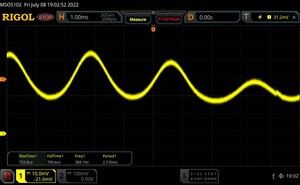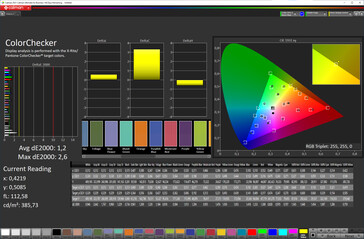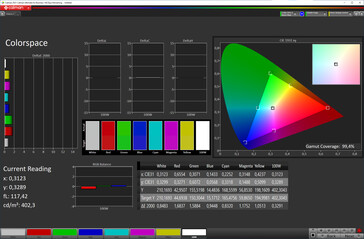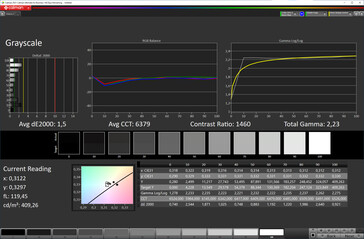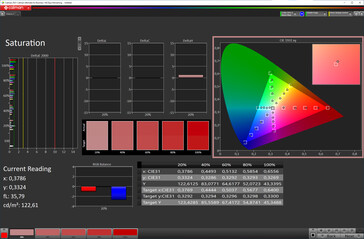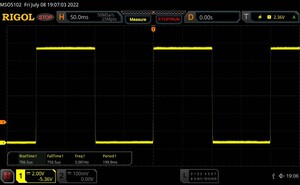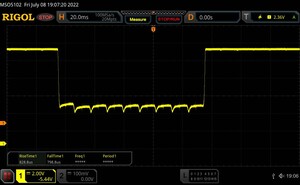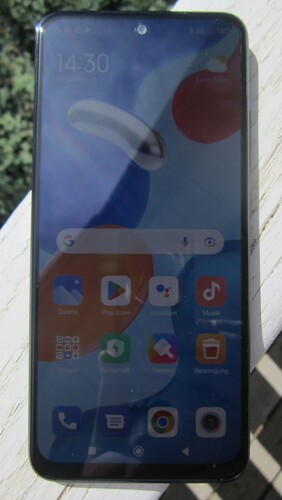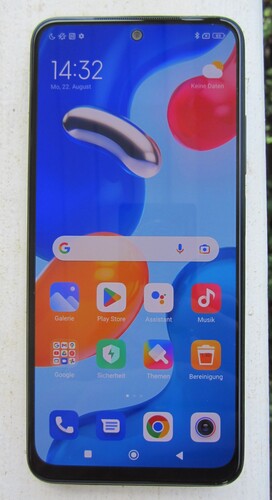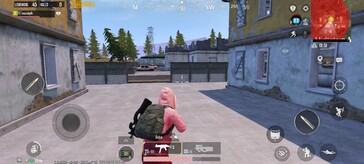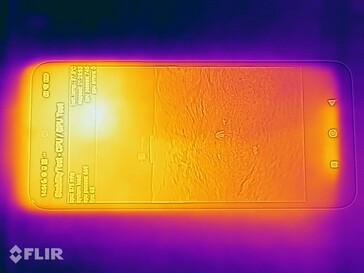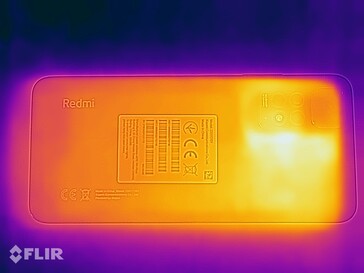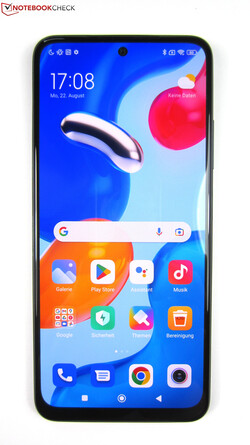Xiaomi Redmi Note 11S smartphone review - 90-Hz AMOLED and 108-MP camera for 200 Euros (~$199)
Those who don't want to spend more than 400 Euros (~$398) for a smartphone will find what they need in the Redmi series from Xiaomi. However, the current Redme lineup starts with smartphones that are even significantly more affordable. You can pick from five mid-range smartphones that officially cost between 170 Euros (Redmi Note 11) and 370 Euros (Redmi Note 11 Pro+ 5G). Despite their affordable prices, there is always an AMOLED display.
For those who set their price limit at 200 Euros, our Redmi Note 11S test unit might be a good fit. The 6.43-inch Android smartphone is equipped with the Mediatek Helio G96 and its integrated ARM Mali-G57 MC2 graphics unit. In addition, there are 6 GB of RAM, up to 128 GB of storage, and other features such as a 108-MP camera and quick charging at 33 watts. Our test shows how the Redmi Note 11S fares in everyday operation.
Possible Competitors in Comparison
Rating | Date | Model | Weight | Drive | Size | Resolution | Price |
|---|---|---|---|---|---|---|---|
| 80 % v7 (old) | 09 / 2022 | Xiaomi Redmi Note 11S Helio G96, Mali-G57 MP2 | 179 g | 64 GB UFS 2.2 Flash | 6.43" | 2400x1080 | |
| 78.9 % v7 (old) | 01 / 2022 | Motorola Moto G31 Helio G85, Mali-G52 MP2 | 181 g | 64 GB eMMC Flash | 6.40" | 2400x1080 | |
| 77.6 % v7 (old) | 05 / 2022 | Realme C35 T7255 (T616), Mali-G57 MP1 | 189 g | 64 GB UFS 2.2 Flash | 6.60" | 2408x1080 | |
| 78.5 % v7 (old) | 03 / 2022 | Nokia G21 T7200 (T606), Mali-G57 MP1 | 190 g | 64 GB eMMC Flash | 6.50" | 1600x720 | |
| 78.1 % v7 (old) | 08 / 2021 | Samsung Galaxy A22 4G Helio G80, Mali-G52 MP2 | 186 g | 128 GB eMMC Flash | 6.40" | 1600x720 | |
| 81.1 % v7 (old) | 06 / 2021 | Xiaomi Redmi Note 10S Helio G95, Mali-G76 MP4 | 178.8 g | 128 GB UFS 2.2 Flash | 6.43" | 2400x1080 | |
| 80 % v7 (old) | 05 / 2022 | Xiaomi Redmi Note 11 SD 680, Adreno 610 | 179 g | 64 GB UFS 2.2 Flash | 6.43" | 2400x1080 |
Case - A light plastic case without IP certification
Xiaomi offers the Redmi Note 11S in the colors Graphite Gray, Pearl White, and Twilight Blue. Its matte surface makes the light, 179-gram (~6.3 oz) Xiaomi fairly impervious to fingerprints.
The case of the Redmi Note 11S impresses with a very good workmanship. Both the frame and back cover are made of plastic, forming a stabile unit together with the AMOLED panel. Although the power key and volume rocker aren't sitting very tightly in the frame, they still offer a very good pressure point.
However, compared to its Redmi Note 10S predecessor, our test unit lost some of its robustness, since Xiami cut out the IP53 certification for the successor. The manufacturer doesn't specify the kind of protection for the display glass. A protective foil covers the display in the state of delivery.
Apart from a few details, the exteriors of the Redmi Note 11S and Redmi Note 10S are similar. The display continues to take up around 84% of the front, and the selfie camera is still housed underneath the punch hole in the center of the top display edge. The back holds a quad camera system with a 108-MP sensor as its core element.
Equipment - Always-on function with 10-second limit
You can select from two Xiaomi Redmi Note 11S models with different storage sizes. The smartphone is available in the web shop of the manufacturer for barely 200 Euros with 6 GB LPDDR4X-RAM and 64 GB of UFS 2.2 storage. On the other hand, the second version with 128 GB of storage costs exactly the same at the time of our testing, so that you can safely ignore the 64-GB version.
Compared to the predecessor, the equipment of the Xiaomi Redmi Note 11S has hardly changed. It continues to lack 5G support and a notification LED. At the same time, the smartphone is still very suitable for everyday tasks. In addition to a microSD card reader, it includes a 3.5-mm audio port, dual-SIM support, a USB-C 2.0 port with USB-OTG support, stereo speakers, an infrared sensor, Bluetooth 5.0, and NFC for contactless payment.
The equipment of the Redmi Note 11S also includes an always-on function. However, the display isn't constantly active but only shows information such as the time and battery level for only 10 seconds after you tapped the screen.
microSD Card Reader
The smartphone reaches solid transfer rates with our Angelbird AV Pro V60 microSD reference card. However, the transfer rate drops significantly in sequential reading after some time. On the other hand, the Redmi Note 11S is almost twice as fast as its predecessor in the copy test.
| SD Card Reader - average JPG Copy Test (av. of 3 runs) | |
| Samsung Galaxy A22 4G (Angelbird V60) | |
| Xiaomi Redmi Note 11S (Angelbird AV Pro V60) | |
| Xiaomi Redmi Note 11 (Angelbird AV Pro V60) | |
| Nokia G21 (Angelbird V60) | |
| Realme C35 (Angelbird V60) | |
| Xiaomi Redmi Note 10S (Toshiba Exceria Pro M501) | |
| Motorola Moto G31 (Angelbird V60) | |
Cross Platform Disk Test (CPDT)
Software - MIUI 13 and upgrade to Android 12
At this point, the Redmi Note 11S runs with Android 12, although it started out with Android 11. This is accompanied by Xiaomi's MIUI version 13 user interface. At the time of our testing (end of August), the Android security patches are at the level of June 1, 2022, so they are still fairly current.
You can delete all the preinstalled third-party apps such as Facebook, Spotify, and AliExpress. The support of DRM Widevine L1 also allows you to play video streams in HD quality.
Communication and GNSS - 4G, stable Wi-Fi 5, and accurate GPS
The Redmi Note 11S isn't particularly talented in terms of mobile communication. 5G isn't supported and there are only 12 supported frequency bands for 4G. However, since band 20 and 28 are also included in the supported bands, you shouldn't encounter any problems with reception, at least within the European area.
The Redmi Note 11S also communicates via Bluetooth 5.0, NFC, and Wi-Fi 5. With our Asus ROG Rapture GT-AXE11000 reference router, the Xiaomi smartphone achieves very stable WLAN transfer rates. At an average of about 340 Mbit/s, they fall within the range of what you can expect from Wi-Fi 5. In addition, the Redmi Note 11S is overall slightly faster in the WLAN as our comparison devices.
| Networking | |
| iperf3 receive AXE11000 | |
| Average of class Smartphone (52 - 1721, n=177, last 2 years) | |
| Xiaomi Redmi Note 11S | |
| Nokia G21 | |
| Xiaomi Redmi Note 11 | |
| Realme C35 | |
| iperf3 transmit AXE11000 | |
| Average of class Smartphone (49.8 - 1828, n=177, last 2 years) | |
| Xiaomi Redmi Note 11S | |
| Realme C35 | |
| Nokia G21 | |
| Xiaomi Redmi Note 11 | |
| iperf3 transmit AX12 | |
| Samsung Galaxy A22 4G | |
| Motorola Moto G31 | |
| Xiaomi Redmi Note 10S | |
| iperf3 receive AX12 | |
| Motorola Moto G31 | |
| Samsung Galaxy A22 4G | |
| Xiaomi Redmi Note 10S | |
The Xiaomi smartphone determines its current location using the GPS (L1), Glonass (E1), Galileo (E1), and Beidou (B1) satellite navigation systems. In our test, it succeeded not only quickly but also very accurately in this. With the GPS Test app, the Redmi Note 11S achieved an accuracy of 2 meters (~6.6 ft) indoors and was even able to increase this to 1 meter (~3.3 ft) outdoors.
The Xiaomi smartphone is also very well suited for everyday navigation tasks. The Redmi Note 11S recorded its route during an approximately 10-km (~6.2 miles) bike ride just as accurately as the Garmin Venu2 fitness tracker.
Telephone Functions and Voice Quality
The dual-SIM smartphone from Xiaomi supports VoLTE and WLAN calls. It delivers a good voice quality in our test. When calling either landlines or mobile phones, the Redmi Note 11S transfers the voices of both conversation partners clearly and easily understandable. In speaker mode, the communication also succeeds easily, and loud noises are filtered out fairly reliably.
In addition to two Nano-SIM cards, the card tray also offers space for a microSD card that can fit up to 1 TB of data. At 0.595 W/kg (head SAR) and SAR 0.936 W/kg (body SAR), the radiation values are comparatively low.
Cameras - Quad-cameras with 108 MP
The selfie camera of the Redmi Note 11S offers a 16 MP resolution and records video at up to 30 frames per second in 1080p resolution. It succeeds in taking solid portrait pictures with easily visible details and colors that look natural. You can optimize the images using a Beauty mode.
The 108-MP main camera uses the Samsung HM2 as image sensor (f/1.9, 1/1.52"). Via 9-in-1 pixel binning, it can take 12-MP pictures and is supported by two 2-MP resolution sensors for macro and depth recordings. When comparing the image quality with that of more expensive smartphones, the Redmi Note 11S will of course lose, but it still creates very decent pictures for its price class.
Under optimal light conditions, the pictures taken with the 108-MP camera look good, particularly if you compare them with those from the Redmi Note 11. Due to its larger image sensor and higher amount of pixel reserves, the Redmi Note 11S is able to capture visibly more image details than its Redmi sibling. In addition, the colors are vibrant, and the images are rich in contrast. On the other hand, the main camera only produces muddy details in zoom recordings. You also have to live with some compromises in night recordings, since they quickly become blurry.
The ultrawide angle camera (f/2.2) offers a viewing angle of 118 degrees and has an 8-MP resolution. In terms of quality, it is unable to compete with the main camera, since it produces images that are visibly noisy even under the best light conditions and also operates at a fairly low sharpness level.
Compared to the Redmi Note 10S, the video characteristics have become worse. In contrast to the MediaTek Helio G95 of the predecessor, the Mediatek Helio G96 of the Redmi Note 11S doesn't allow recording video in 4K but only a maximum of 1080p at 30 FPS. While recording videos, switching between the main and ultrawide angle camera is not possible.
Image comparison
Choose a scene and navigate within the first image. One click changes the position on touchscreens. One click on the zoomed-in image opens the original in a new window. The first image shows the scaled photograph of the test device.
Tageslicht-Aufnahme 1Tageslicht-Aufnahme 2Ultraweitwinkel5-facher ZoomLowlight-AufnahmeOur test lab shows that the main camera is able to reproduce colors fairly accurately (maximum Delta-E of 12.3) under optimal light conditions. In addition, the picture of our test chart is sharp up to the edges. However, at only 1 Lux of lowlight, none of it can be recognized anymore.
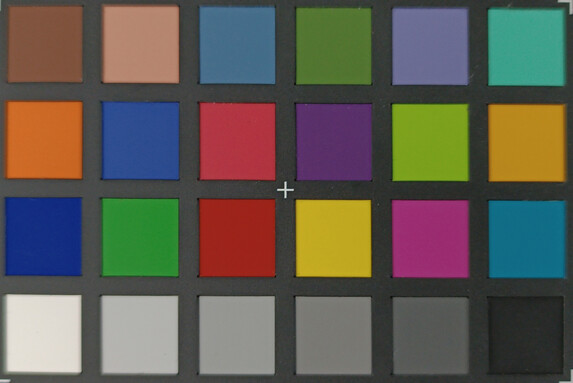

Accessories and Warranty - 33-Watt charger and protective cover
Together with the Xiaomi Redmi Note 11S, a 33-Watt charger, USB cable (Type-A to C), SIM tool, protective cover, and quick start manual are included. The manufacturer doesn't offer any special accessories for the smartphone in its online shop.
The warranty for the Xiaomi Redmi Note 11S covers 12 months.
Input Devices and Operation - Responsive display
Due to its touch scan rate of up to 180 Hz, the capacitive touchscreen of the Redmi Note 11S responds very quickly to inputs, implementing them very accurately. The refresh rate of 90 Hz makes animations and scrolling through menus and websites comfortably smooth.
You can biometrically unlock the smartphone using the fingerprint sensor integrated into the power button. This succeeds quickly and also scores with a high recognition rate. In good light conditions, authentication via 2D face recognition works just as fast, although as a pure software solution, this is less secure than the fingerprint sensor.
Display - AMOLED panel with 90 Hz
The AMOLED display of the Redmi Note 11S offers a resolution of 2400 x 1080 pixels and can be adjusted to a fixed frame rate of 60 or 90 Hz. There is no adaptive control as with some flagship smartphones. HDR is not supported.
At an average of 435.9 cd/m², the AMOLED panel achieves a solid brightness, but our test unit neither reaches the brightness of its Redmi Note 10S predecessor nor that of its current Redmi Note 11 sibling model.
Xiaomi promises brightness levels of up to 1000 Nits for the Redmi Note 11S, but we measure a maximum of 577 cd/m² (APL50 measurements) in its display. Without the brightness sensor activated, it is up to 436 cd/m². At the lowest brightness level, the display still produces 2.42 cd/m².
The AMOLED screen uses pulse-width modulation for brightness control. At a display brightness of less than 54%, the PWM flickering occurs at a fairly high frequency range of between 174.5 and 401.7 Hz. At a display brightness larger than 54%, the frequency is a constant 90 Hz with a very flat and even amplitude level.
| |||||||||||||||||||||||||
Brightness Distribution: 97 %
Center on Battery: 430 cd/m²
Contrast: ∞:1 (Black: 0 cd/m²)
ΔE ColorChecker Calman: 1.2 | ∀{0.5-29.43 Ø4.78}
ΔE Greyscale Calman: 1.5 | ∀{0.09-98 Ø5}
99.4% sRGB (Calman 2D)
Gamma: 2.23
CCT: 6379 K
| Xiaomi Redmi Note 11S AMOLED, 2400x1080, 6.4" | Motorola Moto G31 OLED, 2400x1080, 6.4" | Realme C35 IPS, 2408x1080, 6.6" | Nokia G21 IPS, 1600x720, 6.5" | Samsung Galaxy A22 4G Super AMOLED, 1600x720, 6.4" | Xiaomi Redmi Note 10S AMOLED, 2400x1080, 6.4" | Xiaomi Redmi Note 11 OLED, 2400x1080, 6.4" | |
|---|---|---|---|---|---|---|---|
| Screen | -33% | -124% | -169% | -168% | -6% | 27% | |
| Brightness middle (cd/m²) | 430 | 423 -2% | 585 36% | 492 14% | 349 -19% | 706 64% | 702 63% |
| Brightness (cd/m²) | 436 | 425 -3% | 558 28% | 484 11% | 352 -19% | 701 61% | 701 61% |
| Brightness Distribution (%) | 97 | 94 -3% | 89 -8% | 86 -11% | 92 -5% | 98 1% | 98 1% |
| Black Level * (cd/m²) | 0.6 | 0.46 | |||||
| Colorchecker dE 2000 * | 1.2 | 1.58 -32% | 4.4 -267% | 6.02 -402% | 5.87 -389% | 2.1 -75% | 1 17% |
| Colorchecker dE 2000 max. * | 2.6 | 4.68 -80% | 8.77 -237% | 9.13 -251% | 15.51 -497% | 4.9 -88% | 2.3 12% |
| Greyscale dE 2000 * | 1.5 | 2.7 -80% | 5.9 -293% | 7.1 -373% | 2.7 -80% | 1.5 -0% | 1.4 7% |
| Gamma | 2.23 99% | 2.219 99% | 2.228 99% | 2.345 94% | 2.07 106% | 2.29 96% | 2.2 100% |
| CCT | 6379 102% | 6674 97% | 8001 81% | 8918 73% | 6970 93% | 6447 101% | 6520 100% |
| Contrast (:1) | 975 | 1070 |
* ... smaller is better
Screen Flickering / PWM (Pulse-Width Modulation)
| Screen flickering / PWM detected | 401.7 Hz | ||
The display backlight flickers at 401.7 Hz (worst case, e.g., utilizing PWM) . The frequency of 401.7 Hz is relatively high, so most users sensitive to PWM should not notice any flickering. However, there are reports that some users are still sensitive to PWM at 500 Hz and above, so be aware. In comparison: 53 % of all tested devices do not use PWM to dim the display. If PWM was detected, an average of 8108 (minimum: 5 - maximum: 343500) Hz was measured. | |||
Measurement series with a fixed zoom level and various brightness settings
You can select among the "Vivid," "Saturated," and "Standard" color presets in the display settings. In addition, you can also adjust the color temperature. You get the best color reproduction when switching from the "Vivid" to the "Standard" preset. As our measurements with the CalMAN software and a spectral photometer show, the AMOLED panel will then have only minimal color deviations, all of which also fall within the ideal target range.
Display Response Times
| ↔ Response Time Black to White | ||
|---|---|---|
| 1.46 ms ... rise ↗ and fall ↘ combined | ↗ 0.7065 ms rise | |
| ↘ 0.7505 ms fall | ||
| The screen shows very fast response rates in our tests and should be very well suited for fast-paced gaming. In comparison, all tested devices range from 0.1 (minimum) to 240 (maximum) ms. » 7 % of all devices are better. This means that the measured response time is better than the average of all tested devices (20.2 ms). | ||
| ↔ Response Time 50% Grey to 80% Grey | ||
| 1.63 ms ... rise ↗ and fall ↘ combined | ↗ 0.8288 ms rise | |
| ↘ 0.7988 ms fall | ||
| The screen shows very fast response rates in our tests and should be very well suited for fast-paced gaming. In comparison, all tested devices range from 0.165 (minimum) to 636 (maximum) ms. » 7 % of all devices are better. This means that the measured response time is better than the average of all tested devices (31.6 ms). | ||
Outdoors, the Redmi Note 11S strikes a good figure. If you avoid direct sunlight, the contents of the display can be read without any trouble. Due to the high viewing angle stability of the AMOLED panel, this also works from very steep side viewing angles.
Performance - Hardly any improvements compared to the predecessor
The Xiaomi Redmi Note 11S uses the Mediatek Helio G96 processor. The octa-core SoC that is produced in the 12-nm process offers a clock speed of up to 2.05 GHz and is supported by the integrated ARM Mali-G57 MC2 graphics unit. The Helio G96 is accompanied by LPDDR4X RAM, UFS 2.2 storage, and 4G mobile communication.
The Redmi Note 11S runs through almost all the synthetic benchmarks faster than the comparison devices, also beating the entry-level model of the Redmi Note 11 series, the Redmi Note 11 with its Snapdragon 680. However, compared to the predecessor, our test unit is hardly able to move ahead. In the AnTuTu v9 and PCMark benchmarks, the Redmi Note 10S is even faster.
| CrossMark - Overall | |
| Average of class Smartphone (187 - 2674, n=123, last 2 years) | |
| Average Mediatek Helio G96 (440 - 518, n=2) | |
| Xiaomi Redmi Note 11S | |
| Xiaomi Redmi Note 11 | |
| AImark - Score v2.x | |
| Xiaomi Redmi Note 11S | |
| Average Mediatek Helio G96 (n=1) | |
| Samsung Galaxy A22 4G | |
| Xiaomi Redmi Note 10S | |
| Motorola Moto G31 | |
| Xiaomi Redmi Note 11 | |
| Realme C35 | |
Since with the ARM Mali-G57 MC2, the Redmi Note 11S uses a weaker graphics unit than the Redmi Note 10S, the predecessor is faster in the graphics benchmarks. Overall, the Redmi Note 11S only places in the middle of the field here.
GFXBench (DX / GLBenchmark) 2.7: T-Rex Onscreen | 1920x1080 T-Rex Offscreen
GFXBench 3.0: on screen Manhattan Onscreen OGL | 1920x1080 1080p Manhattan Offscreen
GFXBench 3.1: on screen Manhattan ES 3.1 Onscreen | 1920x1080 Manhattan ES 3.1 Offscreen
GFXBench: on screen Car Chase Onscreen | 1920x1080 Car Chase Offscreen | on screen Aztec Ruins High Tier Onscreen | 2560x1440 Aztec Ruins High Tier Offscreen | on screen Aztec Ruins Normal Tier Onscreen | 1920x1080 Aztec Ruins Normal Tier Offscreen
| 3DMark / Wild Life Extreme | |
| Xiaomi Redmi Note 11S | |
| Motorola Moto G31 | |
| Samsung Galaxy A22 4G | |
| Realme C35 | |
| Xiaomi Redmi Note 11 | |
| Nokia G21 | |
| 3DMark / Wild Life Unlimited Score | |
| Xiaomi Redmi Note 11S | |
| Motorola Moto G31 | |
| Samsung Galaxy A22 4G | |
| Realme C35 | |
| Xiaomi Redmi Note 11 | |
| Nokia G21 | |
| 3DMark / Wild Life Score | |
| Xiaomi Redmi Note 11S | |
| Motorola Moto G31 | |
| Samsung Galaxy A22 4G | |
| Realme C35 | |
| Xiaomi Redmi Note 11 | |
| Nokia G21 | |
| 3DMark / Sling Shot Extreme (Vulkan) Unlimited Physics | |
| Realme C35 | |
| Motorola Moto G31 | |
| Samsung Galaxy A22 4G | |
| Xiaomi Redmi Note 11 | |
| Nokia G21 | |
| Xiaomi Redmi Note 11S | |
| Xiaomi Redmi Note 10S | |
| 3DMark / Sling Shot Extreme (Vulkan) Unlimited Graphics | |
| Xiaomi Redmi Note 10S | |
| Xiaomi Redmi Note 11S | |
| Motorola Moto G31 | |
| Samsung Galaxy A22 4G | |
| Xiaomi Redmi Note 11 | |
| Realme C35 | |
| Nokia G21 | |
| 3DMark / Sling Shot Extreme (Vulkan) Unlimited | |
| Xiaomi Redmi Note 10S | |
| Xiaomi Redmi Note 11S | |
| Motorola Moto G31 | |
| Samsung Galaxy A22 4G | |
| Xiaomi Redmi Note 11 | |
| Realme C35 | |
| Nokia G21 | |
| 3DMark / Sling Shot Extreme (ES 3.1) Unlimited Physics | |
| Realme C35 | |
| Samsung Galaxy A22 4G | |
| Motorola Moto G31 | |
| Xiaomi Redmi Note 11 | |
| Nokia G21 | |
| Xiaomi Redmi Note 10S | |
| Xiaomi Redmi Note 11S | |
| 3DMark / Sling Shot Extreme (ES 3.1) Unlimited Graphics | |
| Xiaomi Redmi Note 10S | |
| Xiaomi Redmi Note 11S | |
| Motorola Moto G31 | |
| Samsung Galaxy A22 4G | |
| Xiaomi Redmi Note 11 | |
| Realme C35 | |
| Nokia G21 | |
| 3DMark / Sling Shot Extreme (ES 3.1) Unlimited | |
| Xiaomi Redmi Note 10S | |
| Xiaomi Redmi Note 11S | |
| Motorola Moto G31 | |
| Samsung Galaxy A22 4G | |
| Xiaomi Redmi Note 11 | |
| Realme C35 | |
| Nokia G21 | |
| 3DMark / Sling Shot OpenGL ES 3.0 Physics | |
| Realme C35 | |
| Xiaomi Redmi Note 11 | |
| Motorola Moto G31 | |
| Samsung Galaxy A22 4G | |
| Nokia G21 | |
| Xiaomi Redmi Note 10S | |
| Xiaomi Redmi Note 11S | |
| 3DMark / Sling Shot OpenGL ES 3.0 Graphics | |
| Xiaomi Redmi Note 10S | |
| Xiaomi Redmi Note 11S | |
| Xiaomi Redmi Note 11 | |
| Motorola Moto G31 | |
| Samsung Galaxy A22 4G | |
| Realme C35 | |
| Nokia G21 | |
| 3DMark / Sling Shot OpenGL ES 3.0 | |
| Xiaomi Redmi Note 10S | |
| Xiaomi Redmi Note 11S | |
| Xiaomi Redmi Note 11 | |
| Motorola Moto G31 | |
| Samsung Galaxy A22 4G | |
| Realme C35 | |
| Nokia G21 | |
| 3DMark / Sling Shot Extreme (ES 3.1) | |
| Xiaomi Redmi Note 10S | |
| Xiaomi Redmi Note 11S | |
| Motorola Moto G31 | |
| Xiaomi Redmi Note 11 | |
| Samsung Galaxy A22 4G | |
| Realme C35 | |
| Nokia G21 | |
| 3DMark / Sling Shot Extreme (ES 3.1) Graphics | |
| Xiaomi Redmi Note 10S | |
| Xiaomi Redmi Note 11S | |
| Motorola Moto G31 | |
| Samsung Galaxy A22 4G | |
| Xiaomi Redmi Note 11 | |
| Realme C35 | |
| Nokia G21 | |
| 3DMark / Sling Shot Extreme (ES 3.1) Physics | |
| Realme C35 | |
| Xiaomi Redmi Note 11S | |
| Xiaomi Redmi Note 11 | |
| Motorola Moto G31 | |
| Samsung Galaxy A22 4G | |
| Xiaomi Redmi Note 10S | |
| Nokia G21 | |
| 3DMark / Sling Shot OpenGL ES 3.0 Unlimited | |
| Xiaomi Redmi Note 11S | |
| Xiaomi Redmi Note 10S | |
| Xiaomi Redmi Note 11 | |
| Motorola Moto G31 | |
| Samsung Galaxy A22 4G | |
| Realme C35 | |
| Nokia G21 | |
| 3DMark / Sling Shot OpenGL ES 3.0 Unlimited Graphics | |
| Xiaomi Redmi Note 11S | |
| Xiaomi Redmi Note 10S | |
| Xiaomi Redmi Note 11 | |
| Motorola Moto G31 | |
| Samsung Galaxy A22 4G | |
| Realme C35 | |
| Nokia G21 | |
| 3DMark / Sling Shot OpenGL ES 3.0 Unlimited Physics | |
| Realme C35 | |
| Samsung Galaxy A22 4G | |
| Motorola Moto G31 | |
| Xiaomi Redmi Note 11 | |
| Xiaomi Redmi Note 10S | |
| Nokia G21 | |
| Xiaomi Redmi Note 11S | |
| GFXBench (DX / GLBenchmark) 2.7 / T-Rex Onscreen | |
| Xiaomi Redmi Note 10S | |
| Samsung Galaxy A22 4G | |
| Xiaomi Redmi Note 11S | |
| Motorola Moto G31 | |
| Xiaomi Redmi Note 11 | |
| Realme C35 | |
| GFXBench (DX / GLBenchmark) 2.7 / T-Rex Offscreen | |
| Xiaomi Redmi Note 10S | |
| Xiaomi Redmi Note 11S | |
| Motorola Moto G31 | |
| Samsung Galaxy A22 4G | |
| Xiaomi Redmi Note 11 | |
| Realme C35 | |
| GFXBench 3.0 / Manhattan Onscreen OGL | |
| Xiaomi Redmi Note 10S | |
| Samsung Galaxy A22 4G | |
| Xiaomi Redmi Note 11S | |
| Motorola Moto G31 | |
| Xiaomi Redmi Note 11 | |
| Realme C35 | |
| GFXBench 3.0 / 1080p Manhattan Offscreen | |
| Xiaomi Redmi Note 10S | |
| Xiaomi Redmi Note 11S | |
| Motorola Moto G31 | |
| Samsung Galaxy A22 4G | |
| Xiaomi Redmi Note 11 | |
| Realme C35 | |
| GFXBench 3.1 / Manhattan ES 3.1 Onscreen | |
| Xiaomi Redmi Note 10S | |
| Samsung Galaxy A22 4G | |
| Xiaomi Redmi Note 11S | |
| Motorola Moto G31 | |
| Xiaomi Redmi Note 11 | |
| Realme C35 | |
| GFXBench 3.1 / Manhattan ES 3.1 Offscreen | |
| Xiaomi Redmi Note 10S | |
| Xiaomi Redmi Note 11S | |
| Motorola Moto G31 | |
| Xiaomi Redmi Note 11 | |
| Samsung Galaxy A22 4G | |
| Realme C35 | |
| GFXBench / Car Chase Onscreen | |
| Xiaomi Redmi Note 10S | |
| Samsung Galaxy A22 4G | |
| Xiaomi Redmi Note 11S | |
| Motorola Moto G31 | |
| Xiaomi Redmi Note 11 | |
| Realme C35 | |
| GFXBench / Car Chase Offscreen | |
| Xiaomi Redmi Note 10S | |
| Xiaomi Redmi Note 11S | |
| Motorola Moto G31 | |
| Samsung Galaxy A22 4G | |
| Xiaomi Redmi Note 11 | |
| Realme C35 | |
| GFXBench / Aztec Ruins High Tier Onscreen | |
| Xiaomi Redmi Note 10S | |
| Samsung Galaxy A22 4G | |
| Xiaomi Redmi Note 11S | |
| Nokia G21 | |
| Motorola Moto G31 | |
| Xiaomi Redmi Note 11 | |
| Realme C35 | |
| GFXBench / Aztec Ruins High Tier Offscreen | |
| Xiaomi Redmi Note 10S | |
| Xiaomi Redmi Note 11S | |
| Motorola Moto G31 | |
| Samsung Galaxy A22 4G | |
| Xiaomi Redmi Note 11 | |
| Realme C35 | |
| Nokia G21 | |
| GFXBench / Aztec Ruins Normal Tier Onscreen | |
| Xiaomi Redmi Note 10S | |
| Samsung Galaxy A22 4G | |
| Xiaomi Redmi Note 11S | |
| Nokia G21 | |
| Xiaomi Redmi Note 11 | |
| Motorola Moto G31 | |
| Realme C35 | |
| GFXBench / Aztec Ruins Normal Tier Offscreen | |
| Xiaomi Redmi Note 10S | |
| Xiaomi Redmi Note 11S | |
| Xiaomi Redmi Note 11 | |
| Motorola Moto G31 | |
| Samsung Galaxy A22 4G | |
| Realme C35 | |
| Nokia G21 | |
In the browser benchmarks, the Redmi Note 11S delivers a good performance. Websites are rendered fairly quickly and can then also be scrolled smoothly. The fairly large advantage to the Redmi Note 10S might primarily be due to the more current browser version.
| Jetstream 2 - 2.0 Total Score | |
| Average of class Smartphone (23.8 - 387, n=149, last 2 years) | |
| Average Mediatek Helio G96 (42.5 - 62.2, n=2) | |
| Realme C35 (Chrome 101) | |
| Xiaomi Redmi Note 11 (Chrome 101) | |
| Xiaomi Redmi Note 11S (Chrome 104.0.5112.97) | |
| Samsung Galaxy A22 4G (Chrome 92) | |
| Motorola Moto G31 (Chrome 97) | |
| Xiaomi Redmi Note 10S (Chrome 91) | |
| Speedometer 2.0 - Result 2.0 | |
| Average of class Smartphone (15.2 - 643, n=122, last 2 years) | |
| Average Mediatek Helio G96 (34.4 - 52.7, n=2) | |
| Xiaomi Redmi Note 11 (Chrome 101) | |
| Realme C35 | |
| Xiaomi Redmi Note 11S (Chrome 104.0.5112.97) | |
| Samsung Galaxy A22 4G (Chome 92) | |
| Motorola Moto G31 (Chome 97) | |
| Xiaomi Redmi Note 10S (Chrome 91) | |
| WebXPRT 3 - Overall | |
| Average of class Smartphone (38 - 380, n=31, last 2 years) | |
| Xiaomi Redmi Note 11 (Chrome 101) | |
| Average Mediatek Helio G96 (55 - 77, n=2) | |
| Xiaomi Redmi Note 11S (Chrome 104.0.5112.97) | |
| Samsung Galaxy A22 4G (Chrome 92) | |
| Motorola Moto G31 (Chrome 97) | |
| Xiaomi Redmi Note 10S (Chrome 91) | |
| Octane V2 - Total Score | |
| Average of class Smartphone (2228 - 121337, n=197, last 2 years) | |
| Average Mediatek Helio G96 (17394 - 19873, n=2) | |
| Xiaomi Redmi Note 11S (Chrome 104.0.5112.97) | |
| Xiaomi Redmi Note 11 (Chrome 101) | |
| Motorola Moto G31 (Chrome 97) | |
| Samsung Galaxy A22 4G (Chrome 92) | |
| Xiaomi Redmi Note 10S (Chrome 91) | |
| Mozilla Kraken 1.1 - Total | |
| Xiaomi Redmi Note 10S (Chrome 91) | |
| Motorola Moto G31 (Chrome 97) | |
| Samsung Galaxy A22 4G (Chrome 92) | |
| Xiaomi Redmi Note 11 (Chrome 101) | |
| Xiaomi Redmi Note 11S (Chrome 104.0.5112.97) | |
| Average Mediatek Helio G96 (2560 - 2773, n=2) | |
| Average of class Smartphone (257 - 28190, n=154, last 2 years) | |
* ... smaller is better
The Redmi Note 11S achieves the largest performance jump compared to the Redmi Note 10S in the storage performance. Even though with UFS 2.2, it nominally uses the same storage type, it is significantly faster in the random read and write access. However, since the sequential transfer rates hardly differ, the load times of apps are about the same.
| Xiaomi Redmi Note 11S | Motorola Moto G31 | Realme C35 | Nokia G21 | Samsung Galaxy A22 4G | Xiaomi Redmi Note 10S | Xiaomi Redmi Note 11 | Average 64 GB UFS 2.2 Flash | Average of class Smartphone | |
|---|---|---|---|---|---|---|---|---|---|
| AndroBench 3-5 | -50% | -2% | -62% | -56% | -29% | 11% | -2% | 184% | |
| Sequential Read 256KB (MB/s) | 524.39 | 309.8 -41% | 907.1 73% | 257.6 -51% | 297.7 -43% | 498.8 -5% | 895.34 71% | 770 ? 47% | 2228 ? 325% |
| Sequential Write 256KB (MB/s) | 446.46 | 221.5 -50% | 271.1 -39% | 180.6 -60% | 183 -59% | 372 -17% | 519.23 16% | 399 ? -11% | 1851 ? 315% |
| Random Read 4KB (MB/s) | 214.82 | 84 -61% | 137.8 -36% | 74 -66% | 101.2 -53% | 110.5 -49% | 172.95 -19% | 156.6 ? -27% | 296 ? 38% |
| Random Write 4KB (MB/s) | 216.24 | 109.8 -49% | 206.4 -5% | 60.2 -72% | 66.9 -69% | 121 -44% | 163.29 -24% | 177.7 ? -18% | 337 ? 56% |
Games - Smooth gameplay is possible
The ARM Mali-G57 MC2 graphics unit used in the Redmi Note 11S is able to display games smoothly, as long as the graphics details aren't set too high. For example, in PUBG Mobile constant 30 FPS are possible in the HD/High setting. In graphically simpler games such as Armajet and Subway Surfers, the frame rates even range around 60 FPS. However, the varying frame rates in Armajet also show that the SoC already hits its performance limits here.
We measure the games' frame rates with our Gamebench test tool.
Emissions - Always running cool
Temperatures
When running, the Redmi Note 11S never gets more than hand warm. Evern after an hour-long constant stress test, we measure a maximum of only 36.3 °C (97.3 °F) on the surface of the Xiaomi smartphone. It is able to use its full SoC performance at almost any time. The performance drops that we measure in the 3DMark Wild Life stress test are so small that they are meaningless.
(+) The maximum temperature on the upper side is 36.3 °C / 97 F, compared to the average of 35.2 °C / 95 F, ranging from 21.9 to 247 °C for the class Smartphone.
(+) The bottom heats up to a maximum of 36.1 °C / 97 F, compared to the average of 34 °C / 93 F
(+) In idle usage, the average temperature for the upper side is 29.5 °C / 85 F, compared to the device average of 32.9 °C / 91 F.
3DMark Wild Life Stress Test
| 3DMark | |
| Wild Life Stress Test Stability | |
| Motorola Moto G31 | |
| Samsung Galaxy A22 4G | |
| Xiaomi Redmi Note 11 | |
| Xiaomi Redmi Note 11S | |
| Wild Life Extreme Stress Test | |
| Xiaomi Redmi Note 11S | |
| Motorola Moto G31 | |
| Samsung Galaxy A22 4G | |
Speakers
The equipment of the Redmi Note 11S includes stereo speakers, which is the exception for the price range up to 200 Euros (~$199). As typical for smartphones, the dual speakers sound rather thin but are still able to reproduce voice fairly well. Bass, however, is rare. On the other hand, the audio port sounds clean and free of noise, with the signal-to-noise ratio at a good 93 dBFS.
You can connect external audio devices with the Redmi Note 11S using the 3.5-mm audio port or Bluetooth 5.0. The usual Bluetooth audio codecs such as AAC, SBC, LDHC, aptX, aptX HD, and aptX Adaptive are supported.
Xiaomi Redmi Note 11S audio analysis
(+) | speakers can play relatively loud (85.5 dB)
Bass 100 - 315 Hz
(-) | nearly no bass - on average 28.8% lower than median
(±) | linearity of bass is average (11.4% delta to prev. frequency)
Mids 400 - 2000 Hz
(±) | reduced mids - on average 5.3% lower than median
(+) | mids are linear (5.3% delta to prev. frequency)
Highs 2 - 16 kHz
(±) | higher highs - on average 7.3% higher than median
(+) | highs are linear (5.4% delta to prev. frequency)
Overall 100 - 16.000 Hz
(±) | linearity of overall sound is average (22.7% difference to median)
Compared to same class
» 49% of all tested devices in this class were better, 6% similar, 44% worse
» The best had a delta of 11%, average was 35%, worst was 134%
Compared to all devices tested
» 66% of all tested devices were better, 6% similar, 28% worse
» The best had a delta of 4%, average was 24%, worst was 134%
Xiaomi Redmi Note 10S audio analysis
(+) | speakers can play relatively loud (88.9 dB)
Bass 100 - 315 Hz
(-) | nearly no bass - on average 33.4% lower than median
(±) | linearity of bass is average (9.6% delta to prev. frequency)
Mids 400 - 2000 Hz
(±) | reduced mids - on average 5.9% lower than median
(+) | mids are linear (5.2% delta to prev. frequency)
Highs 2 - 16 kHz
(+) | balanced highs - only 4.3% away from median
(+) | highs are linear (2.9% delta to prev. frequency)
Overall 100 - 16.000 Hz
(±) | linearity of overall sound is average (20.3% difference to median)
Compared to same class
» 33% of all tested devices in this class were better, 9% similar, 57% worse
» The best had a delta of 11%, average was 35%, worst was 134%
Compared to all devices tested
» 52% of all tested devices were better, 8% similar, 40% worse
» The best had a delta of 4%, average was 24%, worst was 134%
Battery Life - Solid but not outstanding
Power Consumption
The Xiaomi smartphone can be recharged quickly using the included 33-Watt charger. In our test, it took 37 minutes to charge the 5000-mAh battery from 0 to 80%. The battery is then fully charged after 52 minutes.
Interestingly, the charging is hardly any faster with the Xiaomi Redmi Note 11 Pro 5G sibling model at 51 minutes, even though that smartphone uses a 67-Watt charger. Although the Redmi Note 11 Pro 5G charges faster in the beginning, the charging curve then drops fairly quickly, ending up at almost the same charging time.
The power consumption of the Redmi Note 11S is inconspicuous.
| Off / Standby | |
| Idle | |
| Load |
|
Key:
min: | |
| Xiaomi Redmi Note 11S 5000 mAh | Motorola Moto G31 5000 mAh | Realme C35 5000 mAh | Samsung Galaxy A22 4G 5000 mAh | Xiaomi Redmi Note 10S 5000 mAh | Xiaomi Redmi Note 11 5000 mAh | Average Mediatek Helio G96 | Average of class Smartphone | |
|---|---|---|---|---|---|---|---|---|
| Power Consumption | 11% | 19% | -17% | 11% | 4% | -9% | -34% | |
| Idle Minimum * (Watt) | 0.89 | 0.7 21% | 0.8 10% | 1.5 -69% | 0.69 22% | 1.06 -19% | 0.945 ? -6% | 0.842 ? 5% |
| Idle Average * (Watt) | 1.87 | 0.9 52% | 1.1 41% | 2.1 -12% | 1.46 22% | 1.93 -3% | 1.585 ? 15% | 1.439 ? 23% |
| Idle Maximum * (Watt) | 1.9 | 1.3 32% | 1.4 26% | 2.5 -32% | 1.5 21% | 1.96 -3% | 1.7 ? 11% | 1.624 ? 15% |
| Load Average * (Watt) | 3.01 | 3.5 -16% | 3.1 -3% | 2.9 4% | 3.67 -22% | 2.87 5% | 4.41 ? -47% | 7.03 ? -134% |
| Load Maximum * (Watt) | 6.26 | 8.5 -36% | 5.1 19% | 4.9 22% | 5.58 11% | 3.85 38% | 7.43 ? -19% | 11.3 ? -81% |
* ... smaller is better
Power Consumption: Geekbench (150 cd/m²)
Power Consumption: GFXBench (150 cd/m²)
Battery Life
Its 5000-mAh battery contributes to the good battery life of the Redmi Note 11S. In our simulated web surfing, the smartphone lasts for around 12 hours, and when playing videos, slightly longer than 16 hours. However, with the same battery capacity through the bank, all the comparison devices still last significantly longer, including particularly the Redmi Note 10S predecessor.
| Xiaomi Redmi Note 11S 5000 mAh | Motorola Moto G31 5000 mAh | Realme C35 5000 mAh | Nokia G21 5050 mAh | Samsung Galaxy A22 4G 5000 mAh | Xiaomi Redmi Note 10S 5000 mAh | Xiaomi Redmi Note 11 5000 mAh | |
|---|---|---|---|---|---|---|---|
| Battery runtime | 16% | 32% | 50% | 40% | 46% | 15% | |
| Reader / Idle (h) | 27.7 | 35.7 29% | 47.8 73% | 60.2 117% | 35 26% | ||
| H.264 (h) | 16.2 | 21.6 33% | 21.6 33% | 19.5 20% | 17.9 10% | ||
| WiFi v1.3 (h) | 12.1 | 17.2 42% | 16 32% | 18.1 50% | 20.9 73% | 18.1 50% | 14 16% |
| Load (h) | 6.3 | 3.8 -40% | 5 -21% | 6.1 -3% | 6.8 8% |
Pros
Cons
Verdict on the Xiaomi Redmi Note 11S
With the Redmi Note 11S, Xiaomi offers a good smartphone of the lower mid-range. At an official price of 200 Euros (~$199), those who can live without 5G will get a smartphone that offers good workmanship and a solid performance in everyday operation. The Mediatek Helio G96 and 6 GB of RAM ensure that most applications run without any problems and delays become the exception.
For 200 Euros, the Xiaomi Redmi Note 11S offers a lot of smartphone for little money, including an AMOLED screen with 90 Hz. In some respects, however, it is worse than its predecessor.
The Xiaomi smartphone becomes particularly interesting with its AMOLED screen that ensures an attractively smooth operation with its refresh rate of 90 Hz. In addition to the display, the Redmi Note 11S also scores with stereo speakers, a decent battery life, and a 108-MP camera that succeeds in taking good pictures under optimal light conditions. The 33-Watt charger can recharge the smartphone quickly.
The Redmi Note 11S hardly distinguishes itself from its Redmi Note 10S predecessor, offering hardly any advantages besides the more current version of Android and support of DRM Widevine L1. In addition, our test unit isn't any better in some regards: with the change to the MediaTek Helio G96, the graphics performance is weaker, and instead of 4K, now only Full-HD video recordings are supported. The battery life is also worse, and the IP53 certification was removed. An upgrade from the predecessor is therefore not worthwhile.
Alternatives to the Xiaomi Redmi Note 11S are, for example, the Nokia G21 and the Samsung Galaxy A22 4G, which are even more affordable with a similar performance and equipment and also offer a 90-Hz screen. However, only the Samsung also includes an AMOLED screen.
Price and Availability
At the time of our test, the 128-GB version of the Redmi Note 11S is available for example from Amazon for $246. The web shop from Xiaomi also lists the smartphone, but without giving any purchase option in the US.
Xiaomi Redmi Note 11S
- 09/01/2022 v7 (old)
Manuel Masiero




